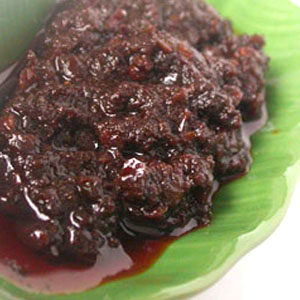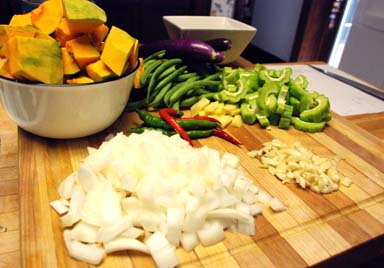Calm down, calm down...
Simple Pinakbet
 |
| Thank you to the http://www.filipinofoodstore.com for the nice bagoong photo. :-D |
Sosy Level: 1
Pawis Level: 3
Ingredients:
2 tbsps cooking oil
4 cloves garlic crushed
1 medium onion
2 large tomatoes chopped
1 tbsp worth of sliced ginger
2 tbsp bagoong alamang
3 tbsps bagoong isda
1 1/2 cup broth of chicken or pork (that is unsalted or just mildly seasoned)
200g pork (or better yet, bagnet!) sliced into bite-sized pieces
200g (or 2 segments) kalabasa, sliced into 1/2 cm pieces
1 ampalaya, sliced and soaked in salted water
4 pcs okra, halved
1 pc finger chili
pepper to taste
How To:
1. Heat a wok then place the oil. When oils is hot, saute the garlic, then the onions.
2. When the onions are translucent, add the tomatoes and ginger, stirring frequently.
3. When the tomatoes are wilted, add the pork (or bagnet), sauteing until the pork has browned a bit.
4. Add the bagoong alamang and isda and sautee until simmering.
tip: You better not be wearing your clothes for that after-dinner coffee date because the fishy (albeit delicious) smell will definitely stick to your clothes.
5. When the bagoong is heated through, add the kalabasa and stir it enough for it to be thoroughly covered with the bagoong mixture. It's like stir-frying at this point. Cook for 2 minutes.
6. Then add the broth. Bring it to a boil then lower heat to let it simmer for about 8 minutes, stirring occasionally.
7. Add the string beans, okra and ampalaya and continue cooking for 3 minutes.
tip: Refrain from stirring too much at this point because it may draw out bitterness from the ampalaya and make the whole dish rather bitter. We don't want that.
8. Check seasoning; if it is still bland, add more bagoong isda according to your taste. Add pepper.
9. When the seasoning is perfect and the string beans are half cooked and still crisp, add the malunggay and chili. Simmer for 1 more minute then turn of heat. We don't need to cook the leaves too much.
tip: If you want a spicy version of this, just cut the tip of the chili (or slice it if you wish) and add it earlier with the string beans.
That's it! There should be enough meat here to appeal to your carnivorous instinct but this is essentially a beginner's course for those who want to get converted from being a carnivore into an omnivore.
Omnivore?
C'mon. Elementary science? They're creatures who eat both meat and plants. I hope you'll find yourself enjoying veggies that you used to frown upon when you were still a kid.
Pawis Level: 3
Ingredients:
2 tbsps cooking oil
4 cloves garlic crushed
1 medium onion
2 large tomatoes chopped
1 tbsp worth of sliced ginger
2 tbsp bagoong alamang
3 tbsps bagoong isda
1 1/2 cup broth of chicken or pork (that is unsalted or just mildly seasoned)
200g pork (or better yet, bagnet!) sliced into bite-sized pieces
200g (or 2 segments) kalabasa, sliced into 1/2 cm pieces
tip: I don't peel my kalabasa, for more nutrients. I also slice them thin so it will take a shorter time to cook and preserve more nutrients.1 bunch string beans, ends removed and cut into 3-inch pieces
1 ampalaya, sliced and soaked in salted water
4 pcs okra, halved
tip: To minimize, if not get rid of the bitter taste of ampalaya, slice the ampalaya lengthwise, scrape the seed then rub the flesh inside with a GENEROUS amount of salt about 30minutes before you cook it. Then slice it to bite size pieces and soak in water for 10 minutes more with all the salt. Then drain and cook according to instructions.1 cup malunggay leaves
1 pc finger chili
pepper to taste
 |
| Thank you for the fantastic picture! http://media123.wordpress.com/2008/07/23/pinakbet/ |
1. Heat a wok then place the oil. When oils is hot, saute the garlic, then the onions.
2. When the onions are translucent, add the tomatoes and ginger, stirring frequently.
3. When the tomatoes are wilted, add the pork (or bagnet), sauteing until the pork has browned a bit.
4. Add the bagoong alamang and isda and sautee until simmering.
tip: You better not be wearing your clothes for that after-dinner coffee date because the fishy (albeit delicious) smell will definitely stick to your clothes.
5. When the bagoong is heated through, add the kalabasa and stir it enough for it to be thoroughly covered with the bagoong mixture. It's like stir-frying at this point. Cook for 2 minutes.
6. Then add the broth. Bring it to a boil then lower heat to let it simmer for about 8 minutes, stirring occasionally.
7. Add the string beans, okra and ampalaya and continue cooking for 3 minutes.
tip: Refrain from stirring too much at this point because it may draw out bitterness from the ampalaya and make the whole dish rather bitter. We don't want that.
8. Check seasoning; if it is still bland, add more bagoong isda according to your taste. Add pepper.
9. When the seasoning is perfect and the string beans are half cooked and still crisp, add the malunggay and chili. Simmer for 1 more minute then turn of heat. We don't need to cook the leaves too much.
tip: If you want a spicy version of this, just cut the tip of the chili (or slice it if you wish) and add it earlier with the string beans.
That's it! There should be enough meat here to appeal to your carnivorous instinct but this is essentially a beginner's course for those who want to get converted from being a carnivore into an omnivore.
Omnivore?
C'mon. Elementary science? They're creatures who eat both meat and plants. I hope you'll find yourself enjoying veggies that you used to frown upon when you were still a kid.
my simple "Pinakbet" includes lots of tomatoes :D
ReplyDelete@española: Oh yeah! I was able to eat a variety that does have a lot of tomatoes. It was really tasty too! Thanks for the tip!
ReplyDelete